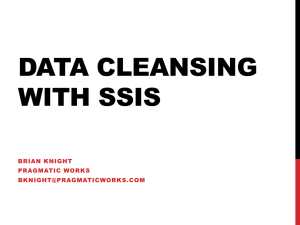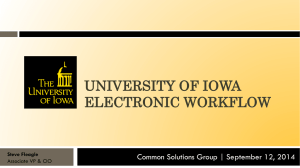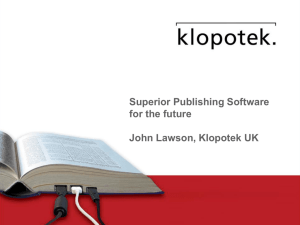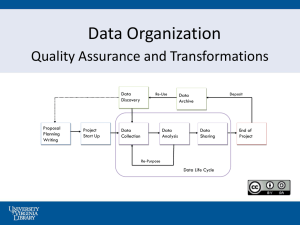Flexible Workflow Systems
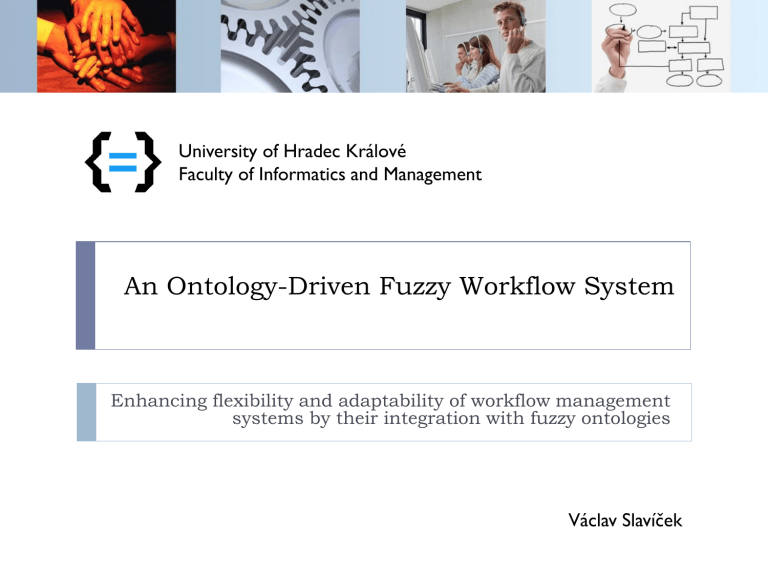
University of Hradec Králové
Faculty of Informatics and Management
An Ontology-Driven Fuzzy Workflow System
Enhancing flexibility and adaptability of workflow management systems by their integration with fuzzy ontologies
Václav Slavíček
1. Introduction
Goals
Integration of the following components:
Ordinary Information System in an organization
Workflow Management System
Knowledge Repository
Vague nature of information in the above systems
Emphasis on the flexibility
Slide 2 28 th Jan 2013
2. BPM and WfM
Examples of Business Process notation
Costomer
Order received
Compare constomer data
XOR
Sales
Customer data
Customer order rejected
Articles available
Customer order accepted
Check
Availability
XOR
Articles need to be produced
Produce articles
Finished product
Sales
ERP - System
Production
XOR
Ship order
Order shipped
Send bill
Bill sent
EPC
Slide 3
BPMN
Source: Tscheschner, W.
Transformation from EPC to
BPMN. Hasso-Plattner-Institut.
[Online] 2008. [Cited: 14 1
2012.] http://bpt.hpi.unipotsdam.de/pub/Public/OryxRe search/TransformEPC2BPMN.
pdf.
28 th Jan 2013
2. BPM and WfM
Workflow management system
Workflow is an element of business process automation in which are documents, information and tasks handed from one process participant to another, according to a set of procedural rules, to achieve a given goal.
Workflow management system provides procedural automation of a business process by management of the sequence of work activities and the invocation of appropriate human and/or IT resources
Source: WfMC. Workflow Management Coalition
Terminology & Glossary. [Online] 3.0, 1999. [Cited: 4 12
2011.] http://www.wfmc.org/standards/docs/TC-
1011_term_glossary_v3.pdf. WFMC-TC-1011.
Slide 4 28 th Jan 2013
Example of workflow notation
2. BPM and WfM
…a guideline for the information system on how a business process should be supported
Slide 5 28 th Jan 2013
3. Background
Background and related work
Flexible and adaptable workflows
Utilization of organizational knowledge in workfow management
Work with vagueness in knowledge representation in workflow management
Slide 6 28 th Jan 2013
3. Background
Flexible and adaptable workflows
Example are knowledge-intensive processes: unstructured unpredictable
Flexibility in workflows … ability to divert from the predefined scenario
Flexibility by selection – ad hoc diversion from the scenario
Flexibility by adaptation (adaptability) – by altering the scenario itself
- “workflow evolution”
Slide 7 28 th Jan 2013
3. Background
Ontology data model
Formalized description of knowledge within a specific domain
Knowledge inference by means of a reasoner
Example: Web Ontology Language (OWL)
Based on Description Logic
Collection of triplets {subject, predicate, object}
Several notations: RDF/XML, OWL/XML, Manchester, Turtle.
Slide 8 28 th Jan 2013
3. Background
Integration
Object-oriented model – commonly used throughout information systems
Ontology model - knowledge repository
Workflow model that supports long-running business processes
Slide 9 28 th Jan 2013
3. Background
Vagueness in the workflow management
Weak workflows
Progressive model
Retroactive workflows
Dynamic workflows
Fuzzy workflows
Slide 10 28 th Jan 2013
3. Background
Fuzzy sets and fuzzy logic
Classic; crisp logic
• 0 .. false
• 1 .. true
Slide 11
Fuzzy logic
• <0;1>
28 th Jan 2013
Fuzzy logic in workflows
Example: Fuzzy BPM – an EPC extension
3. Background
Source: Adam, O., Thomas, O., Gunnar, M. Fuzzy Workflows- Enhancing Workflow Management with Vagueness. German Research Center for Artificial Intelligence (DFKI). [Online] 2003.
[Cited: 14 10 2011.] http://www.tk.uni-linz.ac.at/EUROINFORMS2003_Workflow/rc30_1.pdf.
Slide 12 28 th Jan 2013
3. Background
Fuzzy logic in ontologies
Theoretical framework
• fuzzy SHOIN (D)
Implementation of vagueness in ontology
• FuzzyOWL2,
• FOWL
Implementation in reasoner
• FuzzyDL,
• DeLorean
Slide 13 28 th Jan 2013
4. Goals
Goals
1.
Methodology for designing an ontology-based fuzzy workflow system, with the following properties:
Goal-driven rather than process-driven
Flexible
Transparent
Capitalizes on the organizational knowledge
Works with vague information
Respects the nature of human process participants
Contributes to the workflow model evolution
Easy to implement in real life
Slide 14 28 th Jan 2013
4. Goals
Goals
2.
3.
Building a functional prototype, with a possible re-use of existing components
Evaluation of the viability
Slide 15 28 th Jan 2013
5. Results
Basic Schema
Workflow b Fuzzy workflow f c Fuzzy
Ontology
Ontology d e a
Fuzzy Objects and properties
Object
Oriented
Information
System
Extension of the components with fuzzy logic
Integration
Slide 16 28 th Jan 2013
5. Results
Fuzzy Framework
Component for the fuzzy sets support
Works with existing math expression parser easy to integrate into
an existing information system an existing workflow management system
Support of both discrete and continuous sets
Membership function modelled as a set of polynomial functions on particular disjunct intervals within the domain of definition
Slide 17 28 th Jan 2013
5. Results
Fuzzy Framework - operations
Operations on fuzzy sets by means of standard C#/VB.NET operators
List of opeations on fuzzy sets supported by Fuzzy Framework
Slide 18
Easy implementation of fuzzy logic into
Windows Workflow
Foundation designer.
28 th Jan 2013
FuzzyFramework – example of use
5. Results
Slide 19
Definition of an if-else workflow activity
Workflow continues either one or the other way, based on the fuzzy condition evaluation
28 th Jan 2013
5. Results
Fuzzy Framework – example of use
Graphical output
Slide 20
Hierarchical decomposition of a fuzzy relation
28 th Jan 2013
5. Results
Design of custom workflow activities
Example: Fuzzy task distribution list
Particular tasks assigned to an operator are rich-formatted
Corresponds to the proximity between an ideal and the available operator
Possibility to specify a threshold for maximum proximity
Slide 21 28 th Jan 2013
5. Results
Fuzzy Ontology Framework – integration of
IS with a fuzzy ontology
User
User Interface
Classes
Business Objects
Instance description
Instance categorization
Fuzzy Ontology
Framework inference Fuzzy Reasoner
Fuzzy
Framework
O-R Mapper
Slide 22
Access & modification of ontology concepts & datatypes
Fuzzy Ontology
Editor
Relational Database
Ontology
Administrator OWL ontolgy
( RDF/XML )
Schema of the FuzzyOntologyFramework component
28 th Jan 2013
5. Results
Fuzzy Ontology Framework – integration with a fuzzy ontology
0..*
«metaclass»
OOPL class
+FullName : string
1
Direct integration
1
+mapped by class FullName
1
1
0..*
+is of class
+has instances
OOPL Object
+CustomAttribute1
+CustomAtrribute2
+CustomAttributeN
1
*
Indirect Integration
+mapped by custom attributes
+is exported into OWL as
1
«metaclass»
OWL concept
+subsumes
1
*
*
+is subsumed by
+belongs to concepts
+has members
OWL individual
Hybrid (both direct and indirect) integration of object-oriented and fuzzy ontology model
The goal is to answer the following types of questions: individual-concept affiliation concept subsumption
Slide 23 28 th Jan 2013
5. Results
Feedback from the workflow to the ontology
Logging of processed workflow instances
Transfer of statistics to the main relational DB
Inference of implicit knowledge in the ontology
Alteration workflow execution in the future
Example:
In an insurance company, the assessor is logged for all processed insurance claims
For each employee, they keep the number of processed claims in a statistics.
The ontology contains the following concept:
InsuranceClaimExpert as Employee and numberOfProcessedClaims some highNumberOfClaims
New claims are assigned to employees with the affiliation to concept
InsuranceClaimExpert based on an ontology reasoning.
Slide 24 28 th Jan 2013
Questions
Slide 26 28 th Jan 2013

